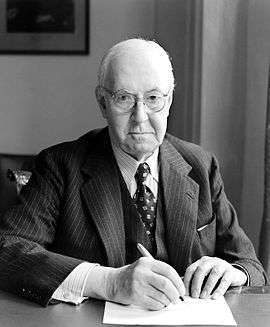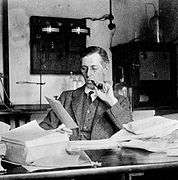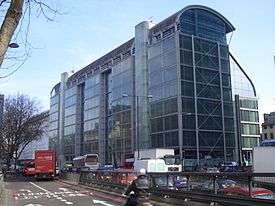Henry Hallett Dale
Sir Henry Hallett Dale OM GBE PRS[2] (9 June 1875 – 23 July 1968) was an English pharmacologist and physiologist.[3] For his study of acetylcholine as agent in the chemical transmission of nerve impulses (neurotransmission) he shared the 1936 Nobel Prize in Physiology or Medicine with Otto Loewi.[4][5][6][7][8]
Sir Henry Dale OM GBE PRS | |
|---|---|
 | |
| Born | Henry Hallett Dale 9 June 1875 |
| Died | 23 July 1968 (aged 93) |
| Nationality | United Kingdom |
| Education | Tollington School The Leys School |
| Alma mater | |
| Known for | |
| Awards |
|
| Scientific career | |
| Fields | |
| Website | www |
Early life and education
Henry Hallett Dale was born in Islington, London, to Charles James Dale, a pottery manufacturer from Staffordshire, and his wife, Frances Anne Hallett, daughter of a furniture manufacturer.[2][9] Henry was the third of seven children, one of whom (his younger brother, Benjamin Dale) became an accomplished composer and warden of the Royal Academy of Music. Henry was educated at the local Tollington Park College and then The Leys School Cambridge (one of the school's houses is named after him) and in 1894 entered Trinity College, Cambridge,[10] working under the physiologist John Langley. For a few months in 1903 he also studied under Paul Ehrlich in Frankfurt, Germany. Also in 1903, Dale assisted Ernest Starling and William Bayliss in the vivisection of a dog, by removing the dog's pancreas and then killing the dog with a knife, which ultimately led to the events of the Brown Dog affair. Dale received his Doctor of Medicine degree from Cambridge in 1909.[11][3]
Career and research
While working at the University College London, he met and became friends with Otto Loewi. Dale became the Director of the Department of Biochemistry and Pharmacology at the National Institute for Medical Research in London in 1914. He became a Fullerian Professor of Chemistry at the Royal Institution in 1942.[12] During World War II he served on the Scientific Advisory Panel to the Cabinet.
Although Dale and his colleagues first identified acetylcholine in 1914 as a possible neurotransmitter, Loewi showed its importance in the nervous system. The two men shared the 1936 Nobel Prize for Medicine.
During the 1940s Dale was embroiled in the scientific debate over the nature of signaling at the synapse. Dale and others believed that signaling at the synapse was chemical, while John Carew Eccles and others believed that the synapse was electrical. It was later found that most synaptic signalling is chemical, but there are some synapses that are electrical.
Dale also originated the scheme used to differentiate neurons according to the neurotransmitters they release. Thus, neurons releasing noradrenaline (known in the United States as norepinephrine) are called noradrenergic, neurons releasing GABA are GABAergic, and so on. This is called Dale's principle (sometimes erroneously referred to as Dale's Law), one interpretation of which holds that each neuron releases only one type of neurotransmitter. This particular interpretation of Dale's principle has been shown to be false, as many neurons release neuropeptides and amino acids in addition to classical neurotransmitters such as acetylcholine or biogenic amines (see cotransmission) (Bear, et al. 2001). This finding, that numerous neurotransmitters can be released by the same neuron, is referred to as the "coexistence principle." This phenomenon was most popularized by the Swedish neuroanatomist and neuropharmacologist Tomas Hökfelt, who is considered to be the "Father of the Coexistence Principle."
Between 1938 and 1960 Dale served as chairman of the Wellcome Trust.[13]
Awards and honours
Dale was elected a Fellow of the Royal Society (FRS) in 1914.[2] In 1926, he was awarded the Cameron Prize for Therapeutics of the University of Edinburgh. He was knighted in 1932, receiving the Knight Grand Cross of the Order of the British Empire in 1943 and the Order of Merit in 1944. He served as President of the Royal Society from 1940 to 1945 and President of the Royal Society of Medicine from 1948 to 1950. The Sir Henry Dale Fellowships of the Wellcome Trust are named in his honour[14] and the Society for Endocrinology awards the Dale Medal[15] annually in his honour.
Personal life
In 1904, Dale had married his first cousin Elen Harriet Hallett and had a son and two daughters. One of their daughters, Alison Sarah Dale, married Alexander R. Todd, who too won the Nobel Prize and served as President of the Royal Society from 1940 to 1945.
 Dale as a child
Dale as a child Dale in 1904
Dale in 1904 Dale in 1918
Dale in 1918 Dale with wife
Dale with wife Son of Henry Hallett Dale
Son of Henry Hallett Dale The Nobel Prize diploma of Dale, displayed in the Royal Society, London.
The Nobel Prize diploma of Dale, displayed in the Royal Society, London. Dale-Schuster blood pump
Dale-Schuster blood pump
References
- Waddington, Keir (2003). Medical education at St. Bartholomew's hospital, 1123-1995. Boydell & Brewer. p. 123. ISBN 9780851159195. Retrieved 20 March 2016.
- Feldberg, W. S. (1970). "Henry Hallett Dale. 1875-1968". Biographical Memoirs of Fellows of the Royal Society. 16: 77–174. doi:10.1098/rsbm.1970.0006. PMID 11615480.
- Tansey, Elizabeth M. (1990). The early scientific career of Sir Henry Dale FRS (1875-1968). ucl.ac.uk (PhD thesis). University of London. OCLC 556469190. EThOS uk.bl.ethos.294137.
- Halpern, B. (1969). "Obituary notice: Henry Hallet Dale". Revue francaise d'allergologie. 9 (2): 117–119. doi:10.1016/s0370-4688(69)80008-6. PMID 4896522.
- Vogt, M. (1969). "Obituary. Sir Henry Hallett Dale, O.M., F.R.S". International Journal of Neuropharmacology. 8 (2): 83–84. doi:10.1016/0028-3908(69)90001-X. PMID 4890938.
- Bynum, William (1970–1980). "Dale, Henry Hallett". Dictionary of Scientific Biography. 15. New York: Charles Scribner's Sons. pp. 104–107. ISBN 978-0-684-10114-9.
- Abigail O'Sullivan: Henry Dale's Nobel Prize winning 'discovery'. Minerva, 2001; 38: 409–424.
- Sabbatini, R.M.E.: Neurons and synapses. The history of its discovery. IV. Chemical transmission. Brain & Mind, 2004.
- Feldberg W, rev. Tansey EM (2004–2011). Dale, Sir Henry Hallett (1875–1968), Oxford Dictionary of National Biography, Oxford University Press, 2004; online edn, Jan 2011. Retrieved 2011-07-08. doi:10.1093/ref:odnb/32694
- "Dale, Henry Hallett (DL894HH)". A Cambridge Alumni Database. University of Cambridge.
- Henry Hallett Dale on Nobelprize.org, accessed 1 May 2020
- "Fullerian Professorships".
- Anon (2015). "Biography of Henry Hallett Dale (1875-1968)". rigb.org. London: Royal Institution. Archived from the original on 8 March 2016.
- Anon (2016). "Sir Henry Dale Fellowships". wellcome.ac.uk. London: Wellcome Trust. Archived from the original on 22 June 2016.
- "Medals | Society for Endocrinology".
External links
- Henry Hallett Dale on Nobelprize.org including the Nobel Lecture, December 12, 1936 Some Recent Extensions of the Chemical Transmission of the Effects of Nerve Impulses
| Wikimedia Commons has media related to Henry Hallett Dale. |

